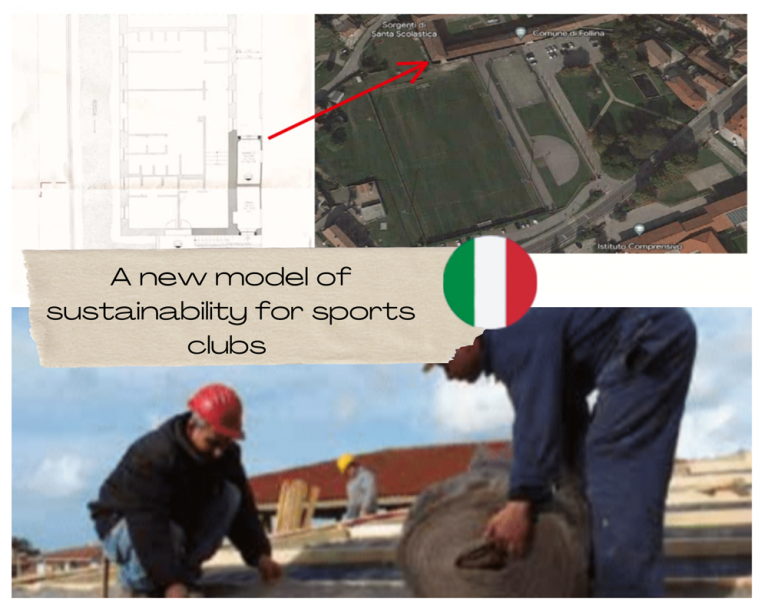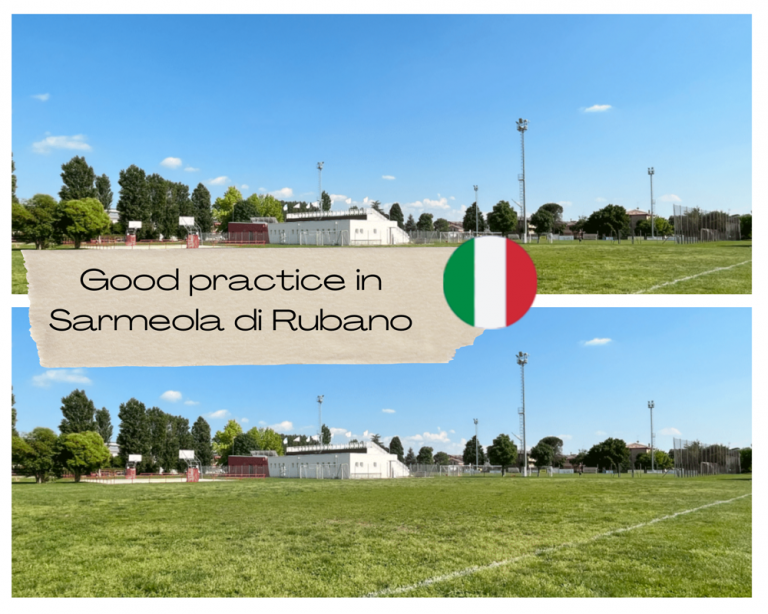Workshop
Anticipation of design workshop outcomes
A new model of sustainability for sports clubs in Treviso

The idea is to introduce a new model of sustainability for sports clubs, by following a series of best practices already existing. By analyzing the area of Treviso, various opportunities for recycling waste materials from companies can be noticed, which can contribute to the new model, for example:
- For the entire structure of the complex, a sponsor can be engaged (as Line Three SRL), which, with its waste materials, will give life to the new facilities;
- For the building insulation and field fertilizer, we will take back the wool scraps that will be supplied by Paoletti woollen mill;
- For the construction of the stands will be made with recycled materials, elements such as the seat, by the company SAVNO in collaboration with ARTISPORT
Main innovation elements can be found in:
Wool as insulation à Sheep’s wool is an elastic and breathable material. It is an excellent conditioning fibre against both cold and heat. It is water-repellent and absorbs moisture. This means that it repels water in liquid form but can absorb water vapour up to 33% of its weight without appearing damp, favoring natural humidity regulation inside homes and reducing the risk of condensation with subsequent damage to the structure. It can absorb and neutralize toxic substances present in the air.
Wool as field fertilizer à Sheep’s wool is an excellent organic fertilizer for a variety of reasons. First, it is rich in nutrients that plants need, including nitrogen, phosphorus and potassium. Second, it helps retain moisture in the soil, which is beneficial during dry spells.
Plastic recycling à After being cleaned, the waste is crushed to obtain plastic flakes, like lots of confetti. At this point, the plastic flakes (in English they are called flakes) are divided by colour by special machinery; then they are heated, cooled, and cut into small pieces
Rethinking sport facilities in Veneto: good practice in Sarmeola di Rubano (PD)

The Sarmeola di Rubano sports facility, currently under private management, is characterized by a single building that includes the secretary, changing rooms for athletes and referees and a small bar under construction. Outside, it comprises three football fields and a basket open area.
“Net” is the word that sums up this research, as parts relate to each other, forming a solid structure.
It is precisely the network in another form that is at the basis of the use of the fields as this deals with the active and constant irrigation that allows an optimal and homogeneous distribution of the turf.
Everything turns into a virtuous circle since their social network reaction is consequent to the excellent functioning of the plant to which the citizens contribute. The intervention identified aims to create a facility that can be visited by members and non-members, a place where the development of a more united community, an environment of personal growth, social aggregation, mediation and sharing. It is proposed to use various types of circular economy to obtain the most significant quantity of products that can be used within the planned interventions through the help of the municipality’s inhabitants to maintain the structure and vitality creation, all in an eco-sustainable and low-cost way.
Among the innovative solutions identified, one example is the LITE NET | Lite Soil GmbH, an innovative system that stores and distributes water gradually. It is a polypropylene net whose practicality consists in its assembly. The system collects rainwater and holds it for release when the land needs it most and, therefore, allowing it irrigation even when the weather conditions are not allow
For dressing rooms, the idea is to propose the “Ethical Project” to the community, which lives the plants, taking and recycling the cork produced by the bar service and brought by the community. The cork recycled will be returned in panels, which will be installed in the dressing rooms, ensuring better thermal and acoustic insulation.
Sport in an healthy environment, the case of Rugby in Venice

San Marco Rugby aim raising youngsters respecting the rules of the sport, in a healthy, attentive environment and inclusive. Their work is based on the fundamental principles of the game of rugby, respect for rules and teammates, support, advancement and would like them to become a lifestyle for their own too players.
The facilities under concession are:
- 2 activity spaces (main rugby field, subsidiary rugby field), covered grandstand with changing rooms
- 2 changing rooms for athletes
- In fact, in sports facilities for rugby, several new technologies in recent years have been introduced to improve the experience of play, athlete safety and officiating. Such technologies are under study by the association to be implemented concretely. Among them:
- Ecological steps for which stadiums have been designed that use renewable energy, such as energy solar and wind;
- Synthetic playing field, an alternative to natural grass, made with resistant and draining materials, these courts offer a surface uniform and consistent, reducing the risk of injury, permitting more intensive use of the field and reducing maintenance;
- LED lighting: The use of such lighting systems can improve the visibility of the playing field, reducing shadowing, improve the quality of light;
- Video surveillance systems and data analysis to monitor the player performance and improve game strategies, these systems used high-definition cameras and intelligent algorithms to provide detailed information about game actions;
- Stadium management systems based on artificial intelligence for manage viewer experience, security, and operational efficiency; These systems use advanced algorithms to analyze the data into real-time and make informed decisions;
- Performance analysis systems, technologies such as devices wearables and sensors used to collect performance data of players during training and matches, this data can be analyzed to identify strengths and weaknesses, improving the activity and effectiveness of game strategies;
- Injury warning systems, technologies such as impact sensors can detect violent impacts or abnormal movements of the players, activating an alarm to signal a possible injury
A project for a more livable Vicenza

The aim of the project is to give a new image to a place loved by people living in the area and beyond. A point of enrichment of a well-defined space; the center of Vicenza sports offers many activities and the intent is to rediscover the Palazzetto, which years before, was one of the iconic places of this center. The project aims to bring it back into play with a new aesthetic and functional aspect that can attract the attention and involvement of a few years before. A starting point for a work already underway, that can return a historical place to the community that is looking forward to revisit it more often
The project was focused on the Vicenza Palazzetto dello Sport. The intervention on the facade and on the perimeter walls of the “Palazzetto dello sport” provides a structure with a dual value, both aesthetic and functional. The structure is composed of a plot of wood slats and “climbing” plants, expanding the green aspect brings benefits to both the individual citizen and the community, taking into account the proximity of sports areas. The roof is entirely covered by solar panels to make the buildingself-sufficient.
In consideration of preserving the environment, solar panels were used to produce clean, renewable energy instead of using the electricity coming from the generation stations. The solar cell system produces approximately 250 watts per cell.
The designed structure can be used in any building or context tobe redeveloped. The illustration demonstrates the insertion of the structure in adjacent buildings to the sports field. Reasoning on a larger scale can be created between the sports field, athletics field “Rosmini” and the “Palazzetto”, a connection not only concerning the activities carried out and services, but also aesthetic and identity. Giving a precise identity to the whole area, which in the future could be called a sports district.

